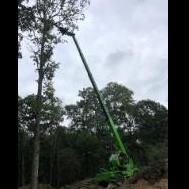
carbs for arbs
Member-
Posts
133 -
Joined
-
Last visited
Personal Information
-
Location:
Carmarthenshire, South Wales
Recent Profile Visitors
The recent visitors block is disabled and is not being shown to other users.
carbs for arbs's Achievements
Collaborator (7/14)
-
Rare
-
-
-
Rare
-
Recent Badges
-
Thank you very much for the response. As far as I've read, a flue draught test is one of three tests which should be performed as part of commissioning. Likewise as part of official safety checks (Landlord certificates, etc.). Some sweeps even suggest that it should be taken as part of an annual sweep and service, although I don't know if that's going too far?! Many thanks
-
Hi Many thanks for the response. Much appreciated. That all sounds very interesting, but perhaps a bit technical for me! I like the sound of it, but aren't sure if a) I'd know what I'm doing, and b) even if I did, how I would then measure or read the results. I've seen the Testo 510 which seems to be the most commonly available but comes in at £150. I've also found this one, which from what I can tell will do what I need at half the price. I've emailed them to be sure. It says it does differential, which I'm assuming is NOT what I need. I'm guessing it will take standard measurements too. RPS Flue Draught Gauge with Probe | RPS - SnapLok WWW.RPS-SNAPLOK.CO.UK RPS Flue Draught Gauge with Stainless Steel Test Kit ***NOTE THIS KIT INCLUDES THE STAINLESS STEEL TEST KIT, SO CAN BE USED STRAIGHT OUT THE BOX*** Differential... It's still an unfortunate layout for a one time use, but I guess that's the benefit of eBay etc! Any thoughts on this unit or any others? Thanks again
-
carbs for arbs started following Restoring and painting old corrugated "iron" / metal roofing sheets (galvanised) , Manometer / Flue Draught Test - any recommendations which gauge to buy (for wood stove flue)? , The Pros and Cons of Direct Air for a Wood Stove (when there’s no mandatory requirement) and and 2 others
-
Hi all I'm looking to do a flue draught test on a wood stove flue and am a bit confused by all of the different manometers available, as it seems they are used to measure all kinds of things. Can anyone recommend one any models that are suitable (and won't melt!)? I'll only be using it once or twice, so the cheaper the better Although if there are budget models I'd also be interested to hear whether they are worth it, reliable, etc. Many thanks
-
Hi all Direct air / External air… Additional air requirements are mandatory for stoves above 5kW in older houses, and for any stoves in newer houses (post-2008) or houses with an air permeability of 5 m3/hm2 or less. I can understand the logic in having DA when the alternative would be an air vent (hole in the wall); although even then there are arguments on both sides. But putting that aside a moment, when no additional air requirements are needed for a stove, is DA still a worthwhile option? I’ve spent the day reading up on this and thought I’d post what I’ve found, as much to share my research as to get feedback and thoughts from people if anyone is interested in discussing it. ***In Favour of DA*** - Draughts. There are quite a few people on the internet who can’t say enough good things about DA and highly recommend using it whenever possible to reduce draughts and cold air in the room. It’s an enticing idea! However, I did notice that this is usually as opposed to having to have an air vent. When the alternative to DA is no air vent (for a 5kW or less stove), I’m not so sure how many of these people would still recommend it. - Draughts – Anecdotes. That being said, I found instances where people were saying they used to have a stove which took air from the room, they weren’t happy with the draughts being created, and so retrofitted a DA feed and it made a world of difference. - Wasting Heated Air. Some say that without DA, you are wasting air in the room that has already been heated and replacing it with cold air. This quote sums it up: “…I would definitely fit a direct air supply not only [for] the prevention of draughts but for the conservation of heat. Using room air you would be using air already heated and a wood burner will use a considerable amount of combustion air out of the room you have heated.” REBUTTAL: However, stoves actually use quite a small amount of air when compared to the average standard air changes required in a room. The air changes will have to happen one way or another, so unless MVHR is used, won’t hot air still have to be replaced with a fresh cold supply regardless? - Colder Air Burns Better. Quote: “The colder the air – the denser it is and more oxygen per unit volume it contains, so it must be good to assist combustion.” REBUTTAL: However, I’m sure I’ve also heard the opposite, that colder denser air is detrimental to combustion. Not sure which is right. - Cold Air Expands When Heated. The claim therefore is that this can assist chimney draw as it is taken away up the flue. - Control. Although DA means less air changes compared to air from the room, it means you have more control over when you ventilate the house. IE – opening windows in the morning, or before going out. You can control the ventilation, and separate the times to ventilate from the times to heat. Also, you can introduce more ventilation when required due to the weather (damp days) and less when not (dry crisp days). As one person puts it, “Using the stove air to ventilate, means you wouldn't ventilate the right amount at the right time.” I thought this article was particularly useful in highlighting benefits, although note the “conditions” on page 2. https://mtbest.net/wp-content/uploads/sites/12/2023/02/cold-air-intake-1.pdf ***Against DA*** - Simply Not Needed. Many people claim DA is not necessary, for various reasons. Also, all of the installers and stove shops I have spoken to (which is quite a few!) have unanimously said not to bother and that we would not gain anything. The “Outdoor Air Myth Exposed” article – link below – claims that it has been studied and DA (or even just air vents) are most often of no benefit. - Stoves Don’t Create Draughts. Some say it is not true that you feel draughts. They say to try putting your hand by the stove’s air inlet, where the air is being sucked through a small aperture and should therefore be the aggregate of all air being pulled. If there were draughts you would feel it there, but you don’t. - Cold Air Cools the Stove. Pulling cold air directly into the stove will be worse for combustion and will cool the internal temperature of the firebox. - Cold Air When Not in Use. The duct will be cold and will emit cold air, especially when the stove is not in use (or even when the stove is in use, to be fair, as it’s still sucking in cold air). Thermal bridge to outdoors. - DA is Worse for Ventilation and Humidity. If the stove takes air from the room, it encourages more air changes in the house. This in turn can increase ventilation and help with humidity too. Outside air is almost always drier/lower RH, so frequent air changes help. - MVHR. Of those people who think DA is a good idea, they sometimes add that MVHR is needed too for air changes. Without MVHR, some say it’s best to vent the stove from the room air. I don’t and won’t have MVHR, so that’s an “against” for me. - Wind and External Air Pressure (Backdraught) Problems. If the wind is at a particular strength and direction it can cause smoke to blow back into the room, as well as CO. It can also make it difficult to start the stove. Unpredictable and variable. There can also be a potential fire risk if the reversal of the flue system flow results in the hot gases being expelled from the DA intake. Also, if mechanical extraction in the house de-pressurises more than the chimney draw, smoke and gases can be drawn out of the stove and into the room. REBUTTAL: See “cold-air-intake” pdf (link above). He says to have the external vent positioned in a place where there will be no wind (consistent known pressure), which would deal with this problem. If that’s not possible, I wonder is something like the DR21 could help with this? - Air from Below Stove (and Entry Into Ash Pan Area). See “cold-air-intake” pdf (link above). He states that the DA needs to be supplied from below the fire as a requirement for it to be effective. This is not possible for many wood only stoves as they have no ash pan. - More Money! Kits are often £100+. Fitting will add to the bill as well (unless DIYing). - Historic Precedent. It’s not how they used to do it in the old days! Older houses need older methods? The strongest article I found arguing DA – and air vents in general – and claiming that studies have proved it: https://www.woodheat.org/the-outdoor-air-myth-exposed.html I appreciate the post is long, and probably quite boring! So feel free to ignore it; although if you've got this far then I guess it's a bit late to say that! But if it interests anyone, I’d love to hear your thoughts, arguments and agreements. Personal experiences always great to hear as well. Cheers
-
Many thanks for the replies. Sorry but we'll be leaving buying the flue etc to the installer so I can't help you there I'm afraid. Apologies, I should have made it clearer. Yes, there's no chimney or fireplace recess. It will be freestanding in a corner, with rigid flue all the way. It's a 25 year old extension on a much older house. I'm glad I'm not alone on thinking it looks awful! But the whole "function over form" question is sometimes a difficult one to resolve... Yes, we'll make sure we used a reputable and trustworthy HETAS registered installer. We've had a few quotes and even amongst installers the single vs twin wall opinion varies, usually with a strong opinion on one side or t'other. Same story on old forum threads, and internet articles. Seems a really divided topic, so any further thoughts and opinions much appreciated before I bite the bullet. Cheers
-
Hi Back again with a second wood stove query, if anyone would be kind enough to share their thoughts please... We're planning to have a stove fitted into a single storey room. The stove has a 5" flue. The installers who have quoted said they think the flue will need to be a total height of 4.5m. It will be a straight run, no bends. If there were to be a single wall flue in the room up until where it has to change to twin to pass through the ceiling, the single wall section would be around 1.6 to 1.7m. The rest would be twin wall, although most of it would be outdoors. We only burn well seasoned hardwoods. From what I've learnt, the advantage of single wall would be more heat to the room. One installer said he thinks for each 1m of single wall flue you get 1kW of heat, which would be a great bonus. I'll also admit a bias - I think the stove looks so much nicer with the single wall 5" flue. I've only found a couple of photos online where the same stove has been installed with twin wall and to be honest I think it looks f-ugly. Also, more space on the stove top for a kettle etc would be an extra bonus. However, I've also learnt that the advantage of twin wall is the flue maintains a higher internal heat, creating a better draw, which results in a stove that is easier to start, runs better, and a flue that doesn't block with creosote so much. (Although I should add that some say they have none of these problems with single wall). It seems to be a very divided topic, with strong opinions on both sides. While I want the aesthetics and extra heat to sway me to single wall, I also don't want a stove that is tough to light and doesn't run well. So over to you guys for some thoughts and insights... Many thanks
-
Here's a link to the official page, with PDF at the bottom for further reading... Many thanks DRU - Ivar 5 Low EA - Dik Geurts freestanding wood or multifuel stove. Output up to 4.9Kw WWW.DRUFIRE.COM Ivar 5 Low EA. Wood, coke or coal burning stove by Dik Geurts. Freestanding with large viewing window in hinged door. Output up to 4.9 Kw Defra compliant for UK smokeless zones
-
Hi We're looking to have a new wood stove installed and have narrowed it down to a Dik Geurts Ivar 5. It's a good size and shape for where we'll be putting it, we like the aesthetic, and it seems to get great reviews on the whole. I wondered if anyone here has one and could share their experiences if so? Or if anyone is familiar with it and has an opinion, good or bad, regarding that particular stove. More wood stove questions may follow over the next few days! Many thanks
-
Many thanks for the replies, much appreciated. Does that mean the un-weathered side will? I wish!!! Approaching 50... Good to hear a thumbs up for bitumen, as many seem to be suggesting more expensive alternatives. I think the problem is there is already rust creeping where previous holes are, as well as around edges. And I wondered if it would get worse exponentially once it takes hold. Looks wise I'm not too bothered and actually quite like the look of them as they are. But seeing as they are only temporarily fixed and the shelters need doing proper, whilst down I thought it made sense to give them the best possible chance of a longer life. But not doing anything would be the ideal IF painting made no difference. Happy to patch paint over both the screws and holes after fixing them down. Makes sense. Hammerite says it doesn't need an undercoat/primer? Also, Hammerite seems about x2 / x3 more expensive than bituminous. Do you think it is worth the extra outlay? Longer protection? Thank you, I'll take a look at those options. Do you think they are all better options than bituminous, and if so do you mind if I ask why? Another vote for cheap option, that's encouraging Thanks, that's good to look at things from another perspective. Tbh, I do prefer to reuse where possible. My time is free. And the equivalent sheets after a quick look seems to be coming in at around £25-£30 each before delivery. I'm estimating I'd need around 25, maybe a little more. So quite an outlay, but worth bearing in mind. Thanks for the tip. I've actually been really surprised (pleasantly) at how little water gets through them, even with existing holes and damage. The wood is staying very dry. Still, the drier the better so I'll see what I've got laying about and/or what I might be able to get my hands on. Cheers all
-
Hi I was donated some "corrugated iron" sheets and have been using them for a couple of years in a makeshift shanty town style array to cover firewood. I want to build proper wood shelters before winter and plan to make use of these sheets. But I'd like to clean them up and protect them as part of the project. It doesn't have to be amazing, the main objective is just to make sure they last as long as possible. I'm pretty sure the sheets are galvanised. There's some old black paint in them which has blistered, flaked and peeled in places. There's also remnants of an old orangey/rusty coloured paint on them which you might mistake for rust at first glance. That being said, there is some rust in places but they're not too bad overall. Bitumen paint seems a common choice. What do you guys think to that? Or are there better alternatives? Also, would I need to use a primer or anything else prior to painting? I've read about rust inhibitors, etch primer, and various other things, some of which people say you should use on galvanised, while others say not to. So feeling a bit confused and hoping you guys can put me on the right path. Many thanks PS - I will be fixing them down properly. Please ignore all the wood and rocks!
-
Many thanks for the replies. The void wasn't filled with anything. Not sure why. Can't remember if it just wasn't discussed at the time or whether the fitter had reasons not to. I know access to the top of the opening in the loft is restricted, so that might have been a reason. Anyhow, it is what it is I guess, and I've no intention of adding it retrospectively as I'd have to undo much of the fitter's work. Thinking about it though, from what I remember the space around the flexi flue liner is not all that much at all. It's a narrow space. Perhaps that's why vermiculite wasn't used? Not sure... Cheers










